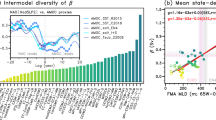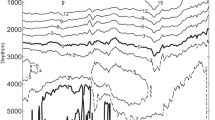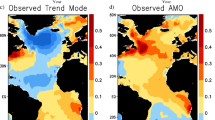Abstract
This study investigates Atlantic Meridional Overturning Circulation (AMOC), Atlantic Multi-decadal Oscillation (AMO), and wintertime North Atlantic Oscillation (NAO) simulated by Flexible Global Ocean–Atmosphere–Land System Models (FGOALS) including version 2 of the spectral model (FGOALS-s2) and fast version and version 2 of the grid-point model, FGOALS-gl and FGOALS-g2, respectively. The models can effectively capture the northward warm and salty sea water transport associated with the AMOC, NAO pressure dipole, and basin-wide sea surface temperature (SST) changes in the North Atlantic associated with AMO. AMOC strength is more realistically simulated by FGOALS-s2 than by the grid models. With the same external forcings, the behaviors of the NAO evolution are highly model-dependent, indicating the importance of climate natural variability. In the grid models, the maps of correlation between winter-mean sea level pressure (SLP) and the NAO index describe a mid-latitude positive center located at the North Atlantic, whereas the positive center in FGOALS-s2 extends eastward to the Mediterranean Sea. The upward trend of the AMO index is evident in the simulations after the 1970s. Moreover, possible relationships among the three indices are examined in this study.
Access provided by Autonomous University of Puebla. Download chapter PDF
Similar content being viewed by others
Keywords
- Atlantic Meridional Overturning Circulation (AMOC)
- Atlantic Multi-decadal Oscillation (AMO)
- North Atlantic Oscillation (NAO)
1 Introduction
Atlantic Meridional Overturning Circulation (AMOC), Atlantic Multi-decadal Oscillation (AMO), and North Atlantic Oscillation (NAO) are important oceanic–atmospheric variabilities in the North Atlantic sector. The AMOC is the Atlantic blanch of global oceanic thermohaline circulation. Sudden changes in the AMOC can trigger abrupt global climate changes on a decadal time scale. The upper limb of the AMOC transports warm and saline water from the tropics northward to the subpolar North Atlantic, maintaining a temperate climate in the North Atlantic region. Multi-spatial variability modes of the AMOC occur at inter-annual to decadal scales (Zhou et al. 2003a). The AMO represents changes of long duration in the sea surface temperature (SST) of the North Atlantic Ocean. This phenomenon is likely natural climate oscillation and can modify the climate in much of the Northern Hemisphere. In the twenteenth century, the time at which the AMO was in its warm phase, the effects of global warming were exaggerated. The NAO is one of the most prominent modes of the atmosphere and describes oscillation between the Azores High and the Icelandic Low in the North Atlantic sector. The NAO can be observed year-round but is more pronounced during the boreal winter. Changes in the NAO have important climate consequences both inside and outside of the North Atlantic sector (e.g., Gong et al. 2001; Yu and Zhou 2004; Li et al. 2008b; Xin et al. 2010).
In this study, we investigate the performance of FGOALS models, including FGOALS-g2 (Li et al. 2013c), FGOALS-s2 (Bao et al. 2013) and FGOALS-gl (Zhou et al. 2008), in reproducing the three indices, and we examine their possible relationships. In particular, we examine the connection of AMOC–NAO and AMOC–AMO variability.
2 Data and Definitions of the Indices
The historical runs performed in the framework of the recent Intergovernmental Panel on Climate Change Fifth Assessment Report (IPCC 2013) were employed in the present study for analysis. The historical simulations were forced by changing conditions, both natural and anthropogenic. In this study, we used the dataset covering 1850–1999.
We defined the three indices as follows:
The AMOC index: The maximum value of the oceanic stream function on the depth-latitude plane in the Atlantic, as reported by Zhou et al. (2005e).
The AMO index: Detrended North Atlantic SST anomalies.
The NAO index: The leading mode of the empirical orthogonal function mode (EOF) of the wintertime SLP in the North Atlantic sector (90°W–40°E, 20°N–70°N). Wintertime in this study refers to the period from December through the following March (DJFM).
3 Results
3.1 AMOC
The monitoring strength of AMOC is approximately 18.5 ± 4.9 Sverdrups (Sv; 1 Sv = 106m3s−1) at 26.5°N (Hirschi et al. 2003). As shown in Fig. 18.1a, the AMOC was strongest in FGOALS-g2 and weakest in FGOALS-gl. The major difference between these two grid models is their horizontal resolution of the atmospheric components. That is, atmospheric interruption can modify the strength of AMOC. The AMOC index in the spectral model (FGOALS-s2) was approximately 21 Sv, which close to the monitoring value. All AMOC indices showed slowing trends of approximately 0.009 Sv/100 yr in FGOALS-g2, 0.026 Sv/100 yr in FGOALS-s2, and 0.013 Sv/100 yr in FGOALS-gl. It should be noted that no coherent evidence existed for the recent AMOC trend, although a weakening of the AMOC was visible in most climate models as a response to increasing greenhouse gases concentration.
a Time series of the annual mean Atlantic Meridional Overturning Circulation (AMOC) indices in FGOALS_g2 (black line), FGOALS_s2 (red line), and FGOALS_gl (blue line). b Climatology state of the annual mean AMOC in FGOALS_g2. c and d are the same as b, but for the AMOC in FGOALS_s2 and FGOALS_gl, respectively. Units: Sverdrup (106m3s−1)
The AMOC structure was reasonably reproduced (Fig. 18.1b–d). In the Northern Hemisphere, it transports warm and salty sea water northward above 1 km, sinks at higher latitudes, and returns to lower latitudes of approximately 1 km to 3 km in depth. However, the details differ among the three models. The Northern Hemisphere maximum AMOC values in the grid models were located at approximately 36°N at depths of 731.4 m in FGOALS-g2 and 914.1 m in FGOALS-gl. The AMOC center in FGOALS-s2 was located at 27°N, approximately 9° South of that in the grid models, and at a depth of 1,203 m.
3.2 NAO and its Correlation with AMOC
NAO variability observed in our simulations can explain more than 30 % of the total SLP variance in the North Atlantic (Fig. 18.2). With the same external forcings, the evolutions of the NAO indices in the three simulations showed incoherent behaviors among the three historical runs. Therefore, we suggest that NAO variability can be explained mostly by internal variability of the climate system. However, anthropogenic climate change may also influence NAO modes (Visbeck et al. 2001).
a Standardized time series of the wintertime (December through March, DJFM) North Atlantic Oscillation (NAO) indices in FGOALS_g2 (black line), FGOALS_s2 (red line), and FGOALS_gl (blue line). Fluctuations of the NAO indices with periods less than 8 years were removed. b Correlation maps between the wintertime sea level pressure (SLP) anomalies and the NAO indice in FGOALS_g2. c and d are the same as b, but for the correlation maps in FGOALS_s2 and FGOALS_gl, respectively. The contributions of the NAO to the total variances are shown at the top-right corner in (b–d)
NAO represents seasaw oscillation between the Icelandic Low over the subpolar region and the Azores High at mid-latitudes in the North Atlantic sector. As shown in Fig. 18.2b–d, the spatial maps of the NAO index-related wintertime SLP anomalies give a well-defined NAO structure with enhancements of the Icelandic Low and Azores High during positive regimes. However, differences were also observed. The amplitude of the Azores High variation was larger than that of the Icelandic Low in FGOALS-g2. The opposite was observed in FGOALS-gl, however. In addition, the Azores High in the FGOALS-s2 shifted more eastward in comparison with that in the grid models.
NAO is considered to be linked with AMOC in the low-frequency spectrum (Bentsen et al. 2004; Zhou 2003b; Zhou and Drange 2005). Therefore, we examined the cross-correlation between the NAO and AMOC indices in the three historical runs (Fig. 18.4a–c). All series were smoothed by an 8-year low-pass filter. In FGOALS-g2, the NAO led the AMOC by approximately 1–2 years, and the AMOC showed negative feedback to the NAO forcing with the AMOC leading by approximately 28 years. Similar positive AMOC response to the NAO forcing and its negative feedback were also observed in FGOALS-s2. However, the NAO forcing tended to lead, by 20 years. In FGOALS-gl, only the negative correlation between AMOC and NAO was significant, with the AMOC leading by approximately 5–6 years.
3.3 AMO and its Correlation with AMOC
In the positive phase of AMO, SST is relatively warm in the North Atlantic. The AMO was generally in its positive phase at the beginning and the end of the simulations (Fig. 18.3a). The long-term evolutions of the AMO indices showed upward trends after 1970s, particularly for FGOALS-g2 and FGOALS-s2. As described in Fig. 18.3b–d, the strong tropical Atlantic warming was effectively reproduced by all three models. Moreover, many hurricane researchers have reported that the tropical North Atlantic warming area is similar to the main Atlantic hurricane activity region (e.g., Goldenberg et al. 2001). SST changes in FGOALS-gl were weaker than the other two models.
a Time series of the annual mean Atlantic Multidecadal Oscillation (AMO) indices in FGOALS_g2 (black line), FGOALS_s2 (red line), and FGOALS_gl (blue line). Fluctuations of the AMO indices with periods less than 8 years were removed. Units: K. b Correlation maps between the annual mean sea surface temperature (SST) anomalies, detrended and smoothed with an 8-year lowpass filter, and the AMO indice in FGOALS_g2. c and d are the same as b, but for the correlation maps in FGOALS_s2 and FGOALS_gl, respectively
AMO is also suggested to be related to variability in the oceanic thermohaline circulation, i.e., the AMOC (Knight et al. 2005). We examined the cross-correlation between the AMO and AMOC indices in the three historical runs (Fig. 18.4d–f). All series were smoothed by an 8-year low-pass filter. In FGOALS-s2 and FGOALS-gl, the AMO led the AMOC by approximately 40 years. In addition, the AMOC showed negative feedback to the AMO forcing with the AMOC leading by approximately 40 years in FGOALS-s2 and 20 years in FGOALS-gl. However, positive AMOC response to the AMO forcing was insignificant in FGOALS-g2, and there is a positive response of AMO to AMOC, with the AMOC leading by approximately 3 years.
Cross-correlation of the Atlantic Meridional Overturning Circulation (AMOC) series with the North Atlantic Oscillation (NAO) indices (left) and with the Atlantic Multidecadal Oscillation (AMO) indices (right). The ordinates represent correlation coefficients. Positive abscissa indicate NAO/AMO leads. The red dashed lines indicate the 5 % significant level according to Student’s t test. (a, d) FGOALS_g2, (b, e) FGOALS_s2, and (c, f) FGOALS_gl. The AMOC, NAO and AMO indices were smoothed to remove fluctuations with periods less than 8 years
4 Summary
Three climate system models, FGOALS-g2, FGOALS-s2, and FGOALS-gl, were used to investigate model performances in reproducing AMOC, AMO, and NAO; all effectively reproduced the spatial structure of the AMOC. The AMOC was strongest in FGOALS-g2 and weakest in FGOALS-gl. In FGOALS-s2, the value was close to observed levels. NAO variability can explain more than 30 % of the total SLP variance in the North Atlantic. However, the strength and position of the centers of the actions differed slightly among the three historical simulations. The NAO-related subtropical high in the North Atlantic in FGOALS-s2 shifted more eastward in comparison with that in the grid models. The Icelandic Low fluctuated in FGOALS-gl with a larger amplitude than that of the Azores High; the opposite was noted in FGOALS-g2. AMO represents detrended SST changes in the North Atlantic Ocean. When the oscillation shifted among phases, the North Atlantic showed basin-wide SST changes. In the simulations, the AMO index strengthened after the 1970s, particularly in FGOALS-g2 and FGOALS-s2.
The relationships among these three indices were also examined. The AMOC showed positive response and negative feedback to the NAO and the AMO forcings; however, the timescales of the response and feedback processes differed in the simulations. AMOC response to AMO forcing was not detected in FGOALS-g2.
Acknowledgments
This work was supported by the Major State Basic Research Development Program of China (973 Program) under Grant No. 2010CB951903 and the National Natural Science Foundation of China under Grant Nos. 40890054, 41205043, and 41105054 and China Meteorological Administration (GYHY201306062).
Author information
Authors and Affiliations
Corresponding author
Editor information
Editors and Affiliations
Rights and permissions
Copyright information
© 2014 Springer-Verlag Berlin Heidelberg
About this chapter
Cite this chapter
Zhang, J., Zhou, T. (2014). The Atlantic Meridional Overturning Circulation, Atlantic Multi-Decadal Oscillation, and North Atlantic Oscillation in Three Climate System Models. In: Zhou, T., Yu, Y., Liu, Y., Wang, B. (eds) Flexible Global Ocean-Atmosphere-Land System Model. Springer Earth System Sciences. Springer, Berlin, Heidelberg. https://doi.org/10.1007/978-3-642-41801-3_18
Download citation
DOI: https://doi.org/10.1007/978-3-642-41801-3_18
Published:
Publisher Name: Springer, Berlin, Heidelberg
Print ISBN: 978-3-642-41800-6
Online ISBN: 978-3-642-41801-3
eBook Packages: Earth and Environmental ScienceEarth and Environmental Science (R0)








